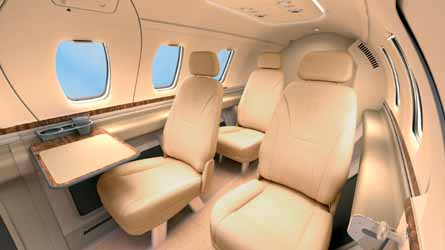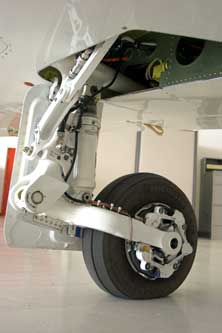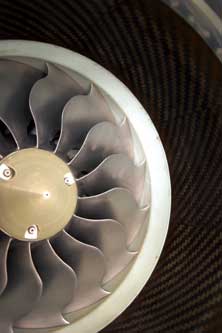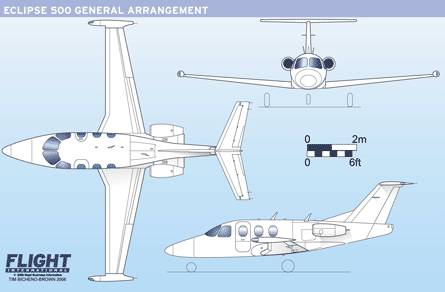by Mike Gerzanics in Albuquerque
The Eclipse 500 is the most talked-about business aircraft in years. But what is the very light jet like to fly? We took the controls of a test aircraft
Eclipse Aviation aims to provide business-jet performance at propeller-aircraft prices, and so bridge the widening divide between private aviation and airline travel. To achieve this, the company has exploited advances in engine, avionics, systems and manufacturing technology to develop a low-cost jet that is easy to fly and cheap to operate. Soon owner-fliers will get to see if it has succeeded.
With Eclipse deeply engaged in the latter stages of US certification, Flight International was able to sample one of two “beta” aircraft used for several purposes including function and reliability testing, pilot training and marketing. The beta aircraft are among five Eclipse 500s involved in a development and certification effort that by mid-April had accumulated more than 1,120 flights since the Pratt & Whitney Canada PW610F-powered aircraft first flew on 31 December 2004. During the 1,570 flight hours logged, the Eclipse’s flight envelope has been expanded from a 67kt (124km/h) stall speed to a maximum dive velocity of 330kt indicated/452kt true airspeed. Continued below
 | |
| We flew N506EA, which aerodynamically is representative of production aircraft, but lacked some avionics | |
 | |
The cabin has adequate room for three pasengers and comfortable seats | |
| The four cockpit windows give an excellent view outside | |
 |  |
| Eclipse is considering extending the electrically actuated main gear; the PW610F engines give 900lb of thrust | |
 | |
| The flightdeck is exceptionally clean:overhead is just an engine control panel,while the autopilot control panel is below the glareshield | |
 | |
| At a casual glance, the Eclipse looks like a conventional aircraft | |
 | |
| All images © Eclipse Aviation | |
The Eclipse 500 seems conventional. The structure is largely aluminium, albeit assembled in a novel and cost-saving way, friction-stir welding eliminating thousands of rivets and hundreds of labour hours. Flight controls are conventional pushrod and cable. While the 900lb-thrust (4kN) PW610Fs are small, there is nothing revolutionary about them. And a glass cockpit is available in most new production aircraft.
Integration system
The Eclipse is at its core an electric aircraft. Major systems are 28V DC-powered from two engine-driven generators and two identical batteries. While this seems conventional, the Eclipse is different in one striking manner – its Avio total aircraft integration system. Five power buses controlled by an electric power distribution system are the brawn of the Avio system, while the brains are dual-redundant aircraft computer systems (ACS). These are split laterally and provide mode-less centralised control of aircraft systems over nine different databuses. The open-architecture Avio is the Eclipse’s central nervous system.
Avio’s benefits are clearly seen on the flightdeck. The forward panel incorporates three colour liquid-crystal displays, supplied by Avidyne. The two smaller, outboard screens are dedicated primary flight displays (PFD), similar to those in other integrated glass cockpits. The Eclipse lacks dedicated control panels for the radios, with control exercised through bezel buttons on the lower edge of the PFDs. The larger central screen is a true multifunction display (MFD). Always displayed on the upper portion of the MFD are a standby flight instrument display, crew-alerting system messages, critical engine instruments and aircraft configuration graphics. The lower portion can be used for any of five displays: audio, checklist, flight management system (FMS), map and systems. The latter brings up synoptic pages for several systems. The audio page allows control of pilot headset volume and intercom features – there is no dedicated switch panel.
The flightdeck is exceptionally clean. Overhead there is an engine control panel and nothing else, while below the glareshield is an autopilot control panel. Outboard of the left PFD is one of only two conventional switch panels in the cockpit; it has six electrical master switches, two conventional circuit breakers (CB), and controls for bleed air and oxygen systems. The rest of the CBs are electrical, and I found their control via the MFD straightforward. Below the MFD is the centre switch panel, housing the landing-gear lever and lighting switches. The throttle quadrant is also quite clean; on production aircraft it will house two thrust levers, a three-position flap handle and a rudder trim knob.
Evaluation flight
The beta aircraft used for our evaluation flight, first flown in August 2005, was aerodynamically representative of the production aircraft, but its avionics and systems were not up to planned delivery standards. In particular it lacked the autopot, yaw damper and GPS receiver.
The cabin interior was complete, with the three standard passenger seats, but was not representative of the Ideo-styled production product.
Terry Tomeny, chief of flight-test engineering, conducted the pre-flight inspection. The Eclipse was as easy to pre-flight as any single-engined Cessna I have flown – easier in that a ladder is not needed to check security of the fuel caps. I was struck by the high quality of the exterior finish. Entry to the cabin is via a two-piece manual door, similar to that on Bombardier Learjets, split below its mid-point. The bottom half incorporates two steps. A single static seal rims the door opening for pressurisation and acoustic purposes.
Once seated in the left-hand pilot seat, I found the field of view out of the four cockpit windows to be large. The range of adjustment for the manual seat was good, but I found the rudder pedal adjustment mechanism difficult to operate. Mounted outboard, the manual sidestick fell readily to hand as did the two thrust levers. An external electric cart was connected for engine start. The nose-mounted, electric-powered vapour-cycle air conditioner kept the cockpit cool on the sunny 21°C (70°F) day as pre-start flows were accomplished.
This beta aircraft had an early software load, and lacked an FMS and electronic checklist. While unable to evaluate the FMS, I would be surprised if it was not straightforward, given it is based on Avidyne’s proven Entegra system. The engine start sequence was simple. The right (number 2) engine was started by rotating the overhead panel start switch to the Start/Run position. Full-authority digital engine controls managed the start, with inter-turbine temperature (ITT) peaking at 617°C, well below its 800°C limit. An idle RPM of 55.1% N2 (core speed) was reached in about 30s. The right engine generator came on line, automatically disconnecting the ground power cart. Left engine start was essentially identical, ITT peaking at 612°C.
With the flaps set to take-off, a bump of the thrust leavers was needed to get the aircraft rolling for taxi to Albuquerque International’s runway 21. Rudder pedal-controlled nosewheel steering (NWS) provided ±15° of control, allowing accurate tracking of straight taxiway centrelines. For tighter turns, tapping the inside toe-actuated mainwheel brake allowed the nosewheel to caster, making 90° turns a snap. The combination of direct nosewheel control and castoring ability was easily mastered, and far easier than taxiing jets that have fully castering nosewheels.
Take-off
With 678kg (1,495lb) of fuel (maximum is 699kg) and three occupants (with no baggage) take-off gross weight was 2,538kg, just below the maximum of 2,558kg. When cleared for take-off, I rapidly advanced both thrust levers to their forward stops. The FADECs stabilised the engines at 89.9% N1 (fan speed).
Acceleration was fairly brisk given the ambient density altitude of 7,270ft (2,220m) (runway elevation is 5,355ft). At the computed rotation speed of 90kt (167km/h) indicated airspeed, less than 7kg of aft stick force was needed to attain a take-off attitude of 10°. The aircraft lifted off the runway after a ground roll of less than 700m. At sea level and maximum take-off weight, Eclipse is projecting a take-off distance (to clear a 15m obstacle) of 657m. Production aircraft will have an FMS-based performance computer. Gear and flap retraction caused negligible pitch force changes as the aircraft was accelerated to a climb speed of 150kt.
During the climbout, I found pitch trim easily zeroed out control forces, enabling me to maintain the climb schedule. A series of banks and turns during the climbout showed roll performance to be fairly precise, allowing accurate initial capture of desired headings and bank angles. Turbulent air during the climbout frequently excited the Dutch roll lateral-directional mode, causing an uncomfortable fishtail motion. Our aircraft lacked the yaw damper planned for production Eclipses. US certification rules require that any Dutch roll oscillations must damp out to 1/10th amplitude after seven cycles, or a yaw damper must be installed. I feel the flying qualities will be improved by its installation. Tomeny said the servos are installed, and the yaw damper will be connected once autopilot testing is complete.
Also during the climb to flight level 320 (32,000ft) I found the aircraft heading was wandering off the desired course. The Eclipse has two independent attitude heading reference systems (AHRS). The left AHRS supplies data to the left PFD, and the right one the right PFD. Cross-checking them revealed that there was 2-3° difference in roll attitude, the left AHRS seemingly the inaccurate one. Being a heavily flown developmental aircraft, small glitches like this crop up from time to time, and Eclipse will no doubt ensure the AHRSs in production aircraft are true.
Less than 24min after take-off, the aircraft was levelled at FL320. Fuel burned from brake release was 100kg, with an average rate of climb of 1,100ft/min (5.6m/s). With the power set to maximum continuous, the aircraft was allowed to accelerate and reach a maximum speed of 180kt/Mach 0.52. Outside air temperature was -55*C, and total fuel flow 192kg/h (424lb/h).
Tomeny took control of the aircraft as I left the cockpit to sample the cabin. The seats were comfortable and, while by no means spacious, the cabin seemed to provide more than adequate room for three passengers. The ambient noise level was fairly low, on par with many of the business jets I have flown.
Before initiating a simulated emergency descent, I did several 60° angle-of-bank steep turns at 170kt indicated. Longitudinal stick forces were linear as back pressure was increased to maintain level flight at increasing bank angles. There was no airframe buffet as the nose of the aircraft tracked smoothly across the horizon. Bank angle was decreased to 30° and power retarded to idle for an emergency descent, simulating a loss of cabin pressure. A 10-12° nose-low spiral descent was initiated, and airspeed was allowed to build to the maximum operating 285kt.
Two minutes and 40 seconds after starting the descent, we passed through 15,000ft, for an average rate of descent of over 6,500ft/min. Eclipse is investigating partially extending the robust, electrically actuated main gear about 10° into the airstream for even greater rates of descent.
Stall warning
After climbing the 2,313kg aircraft back up to 17,000ft, I lowered the landing gear and extended the electric flaps to full down. Slowing at 1kt/s in a wings-level attitude, I heard an aural “Stall Stall” at 74kt. Ignoring the warning, I continued to apply aft stick pressure until the right wing dropped at 70kt. Left rudder was able to counter the roll off, and lowering the nose to decrease the angle of attack recovered the aircraft to unstalled flight. A clean-configuration stall followed. The aural stall warning sounded at 95kt, followed shortly by light aerodynamic buffet. At 90kt the left wing dropped, again easily countered by application of rudder. As with the landing-configuration stall, control authority in all three axes was good, especially in the pitch axis. For the production aircraft, Eclipse will install a stick pusher, and it will be used to define the stall. Eclipse is aiming for a stall speed of 67kt at sea level and MTOW.
We transited at medium-altitude Double Eagle airport, north-west of Albuquerque International, and shot a number of visual patterns at this uncontrolled field. Several other light aircraft joined the pattern. The Eclipse’s low-speed capability, 120kt with take-off flaps in this instance, allowed us to coexist peacefully with those unfortunate chaps still watching through their windscreens at whirling propellers. Due to gusty winds we held a speed on final of 90kt with gear down and flaps full down, faster than the 82kt reference speed. Left to its own devices, ground effect practically lands the Eclipse, gently braking the descent rate. The trailing-link main landing soaks up a lot of inertia, allowing the Walter Mittys of the world to feel like Sky King.
After lift-off on the last touch-and-go at Double Eagle, Tomeny pulled the left thrust lever to idle, to simulate an engine failure. At power settings above maximum continuous an automatic power reserve (APR) feature is armed. Activated by the loss of an engine, as determined by a split in N1 or N2 or loss of FADEC communication, thrust on the good engine is increased 10%. The engines are only 886mm (34.9in) off aircraft centreline, and the resulting yawing motion was easily controlled by right rudder. Less than 20kg of pedal force was needed to maintain co-ordinated flight. Available rudder trim was insufficient to zero out pedal forces at take-off power. But with the power on the good engine reduced at pattern altitude, available rudder trim allowed for feet-on-the-floor co-ordinated flight.
Single-engine safety
At sea level and MTOW, Eclipse publishes a single-engine climb rate of 888ft/min. At 5,000ft and ISA +15°C Eclipse forecasts a single-engine rate of climb after take-off of 293ft/min. Compared with some piston twins whose single-engine climb rates are negative numbers, the performance offered by the Eclipse should significantly enhance operational safety. For the part-time pilot, an engine failure on a jet may be easier to handle than in a propeller aircraft, as there is no fumbling about for the condition lever to feather the prop.
Transiting to Albuquerque with both engines, the left engine was again retarded to idle on base leg. Final approach was flown with flaps at the take-off setting and landing gear down. At around 500ft above ground level, the flaps were extended fully down. As thrust on the right engine increased to counter the additional drag of full flaps, more right rudder was needed to maintain co-ordinated flight. Like most light aircraft, the Eclipse is landed in a wing low attitude when confronted with a crosswind. We had a fairly strong left crosswind for our full stop landing on runway 26.
At roughly 100ft I kicked out the crab to align the aircraft with the runway centreline, requiring more right rudder. Pedal forces were reasonable, but lateral stick (roll) forces quite high. As I had observed during my manoeuvres at high and medium altitudes, roll control forces in general were high, with those for left wing down rolls seemingly higher than those for right wing down rolls. The control force gradient in fact is nearly identical for both directions. What is not identical is one’s forearm strength. In general a person has greater strength pulling towards their torso than pushing away from it. The combination of a simulated left engine failure and left crosswind required a large steady left-roll input, making my left forearm quite relieved when we touched down. While the roll control forces where higher than I would have liked, a Pilatus PC-12 pilot might find them to be on the light side.
The Eclipse was at once familiar, but yet unlike anything I had ever flown before. It is a twin-engine jet, but has light aircraft weights. It can climb to 41,000ft, yet it felt at home in the traffic pattern mixing it up with single-engined Cessnas. For the cost of a glass-panel upgrade on a mid-sized business jet, you can get the entire Eclipse 500 with its Avio integrated fightdeck.
During my 2h evaluation flight I found the Eclipse to be a docile performer, with admirable single-engine flight characteristics. In many ways it was easier to fly than the piston twin I took my air transport pilot rating ride in. It does not have the gravitas of a Gulfstream, but the Eclipse will take you higher, faster and further than a Beech Baron for a slight price premium. The cabin could be bigger, but aircraft are sold by the pound and the Eclipse seems an incredible value.
Inexpensive jet
Eclipse set out to deliver an aircraft for $1 million, and initial positions are just below that mark. If you order an aircraft today it will cost $1.445 million. While that sounds like a princely sum, it does not go far when buying a new aircraft. Cessna is asking $2.5 million for its slightly larger Citation Mustang VLJ, $1.9 million will get you a single-turboprop Piper Meridian, and Beechcraft’s G58 Baron piston twin lists at just over $1.2 million. Any number of used business jets are available in the Eclipse’s price range, but they will undoubtedly have higher direct operating costs (DOC). Eclipse is projecting a DOC of $0.71/km ($1.15/nm), with fuel factored in at over $0.62/litre ($3/USgal)
While certification remains a big hurdle, Eclipse is passionate about delivering its category-defining aircraft to the masses. The “Southwest Airlines effect” – bringing new customers to the market – is well documented. Perhaps Eclipse will be in the vanguard for the revitalisation of general aviation in the USA.
Source: Flight International
















